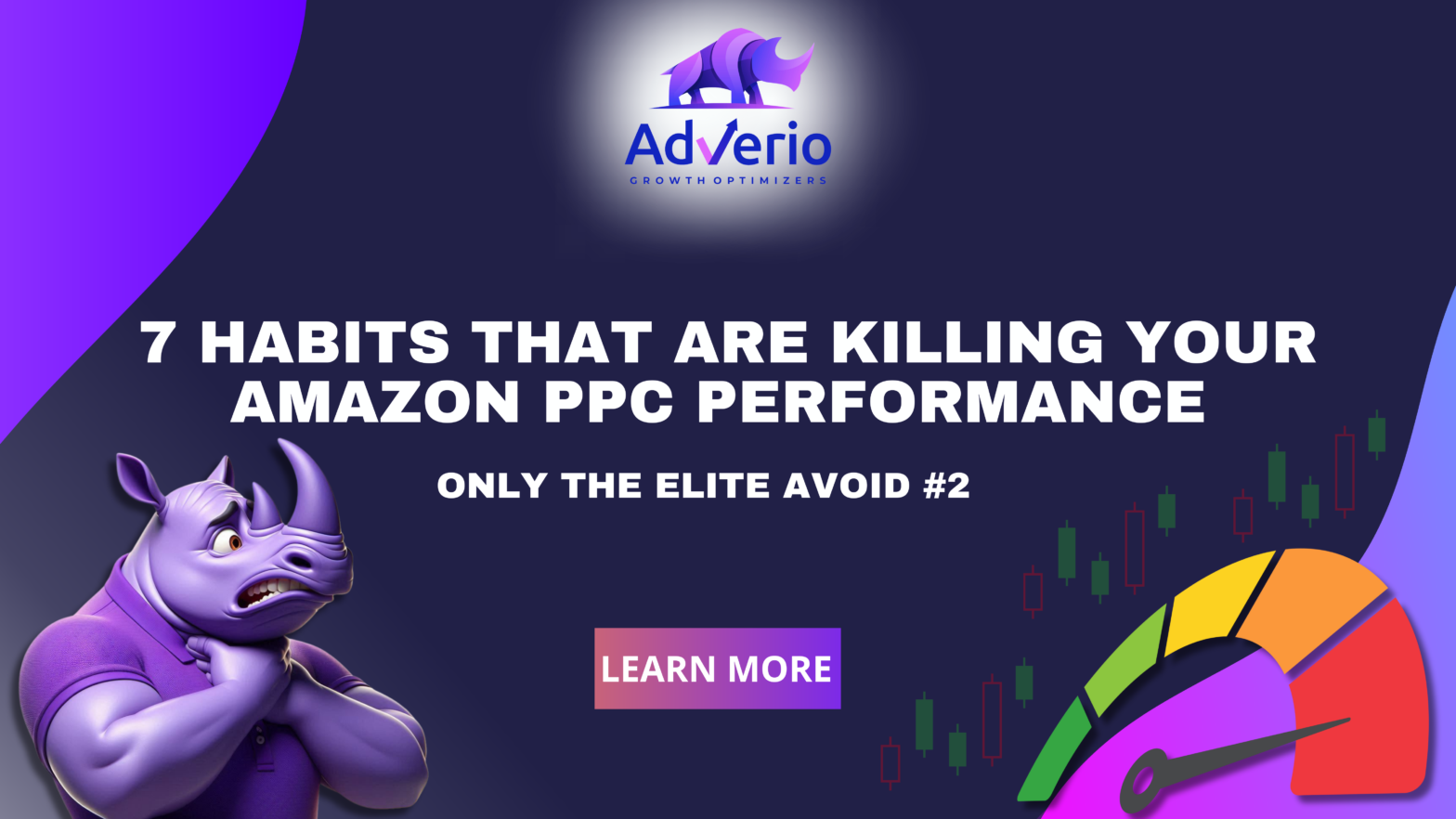Understanding Amazon PPC Performance in Detail
Amazon PPC can be a powerful tool for growing your business when used effectively. Effective Amazon PPC management involves more than just setting up campaigns. It requires a deep analysis of keyword performance, competitive landscape, and consumer behavior. However, many sellers fall into common habits that can end up hurting Amazon PPC performance over time.
#7 Habits That can Hurt your Amazon PPC Performance
Amazon Pay-Per-Click (PPC) advertising can be a great way to generate sales if done correctly. However, there are some common habits that sellers engage in that can negatively impact their campaign performance over time.

1. Beyond the Numbers: Audits as a Strategy-Shaping Tool
Audits often start with raw data—clicks, TACoS, and impressions—but they should delve much deeper. An effective PPC audit serves as a strategic lens through which you can examine numbers, patterns, and performance trends that help inform your overall business strategy.
Your audit should illuminate areas where ad spending may be more vanity than sanity. It must also surface new growth potential and reveal threats like competitor encroachment on crucial shoppers. This deeper, ongoing audit approach uncovers the narrative behind the numbers and allows you to act proactively.
2. The Dangers of Not Re-testing and “Set It and Forget It”
While an ad type, ad placements, target or keyword, video asset, headline copy, audience, and everything in between may not have worked during Q2, that doesn’t mean it will not work during Q4 or even the following year’s Q2. Your audience is constantly shifting.
Trendy catchphrases come and go. We’ve seen brands just a tad too early to the game for a particular ad and had written off the campaign to find out later it was a total banger lying in wait.
Similarly, a “set it and forget it” approach is tempting but ultimately costly. Amazon’s advertising ecosystem is highly dynamic, with competition and costs shifting on a dime.
Left unchecked, even once-profitable campaigns can start bleeding budget, losing visibility, or trailing in rank. Regular, strategic audits allow you to:
- Identify when a top-performing keyword or campaign placement has become less relevant or more competitive.
- Avoid gradual budget drift, where inefficient spending accumulates, decreasing overall ROI.
- Prevent competitor advances on your most valuable keywords or placements.
Continuous auditing lets you spot these changes before they deplete your hard-earned cash flow, keeping your brand resilient and competitive.
3. Audit Goals Matter: Tailoring to Your Business Objectives
We see this over and over again. Many audits go wrong by following a rigid checklist rather than considering the business’s specific goals. Are you focused on driving top-line growth, protecting brand share, or maximizing profitability? Each objective requires a different PPC audit focus:
- Growth-Centric Audits: Focus on efficacy via high-potential keywords, targets, audiences, placements, and campaign types where incremental spending yields higher visibility and market share. Target keywords with strong advantages over the competition and identify gaps monthly or at least quarterly.
Be weary of vanity pursuits by avoiding ad placements where the competition is clearly stronger than your offer by way of CTR, reviews, pricing, shipping times, etc. Your Search Query Performance Report is a gold mine for these hidden gems.
- Profit-Centric Audits: Hone in on efficiency, non-converting keywords, and CPA by placement to refine budget allocation, ensuring that every dollar directly supports profitable growth.
- Brand Protection Audits: Identify where you need to protect branded traffic to prevent competitor encroachment, enhancing your brand’s staying power on crucial IP traffic. Again, Your Search Query Performance Report can surface where you may have leaks via your branded traffic and provide objective data that you may not even have to run ads since you don’t lose conversion share.
Aligning audits to your core objectives ensures that you’re optimizing campaigns and steering your overall Amazon business strategy.
4. The Power of Targeted Keyword Strategy and Competitor Analysis
A core focus of any Amazon PPC audit should be keyword and competitor strategy, but this requires more than a keyword report. Use audits to explore questions like:
- Are you dominating high-value keywords, or is your market share slipping? Monitoring keywords across branded, non-branded, and competitor-targeted categories lets you adjust bids and placements to maintain leadership.
- Are you expanding in underutilized areas? Continuous audits reveal opportunities in overlooked keywords or placements where lower bids could still yield strong conversions.
Knowing not only where you stand but also where your competitors stand allows you to preemptively adjust your strategy, ensuring that you’re ahead of the curve.
5. Health vs. Efficiency: Balancing the Metrics That Matter
A robust PPC audit measures two critical elements: health (the structural soundness of your account) and efficacy (budget effectiveness and ROI). Both are equally important, and the right metrics can guide adjustments with precision.
Key Health Metrics
- Campaign Structure Balance: Ensures your ad types (Sponsored Products, Sponsored Brands, Sponsored Display) are optimized for reach and visibility, identifying any underutilized ad types as easy wins.
- Placement Analysis: Placement matters—Top of Search performs differently from product pages. Analyze cost and conversion by placement to optimize where your ads appear.
- Branded vs. Non-Branded Traffic: Branded traffic can often be a crutch for underperforming campaigns. Heavy reliance on branded keywords limits reaches, while optimizing non-branded terms builds growth beyond existing customers.
Key Efficiency Metrics
- High ACoS Keywords: If your strategy doesn’t include ranking goals, consider adjusting or pausing high ACoS keywords, especially if they aren’t delivering sales or visibility benefits.
- Non-Converting Keywords: Keywords that fail to convert can quickly bleed budget, especially when compounded across too many targets simultaneously. Assess each for relevance and test creative changes, but ultimately, be ruthless with those who don’t perform.
- Top Revenue-Generating Keywords and SKUs: Track spend and conversions for SKUs and keywords regularly, ensuring your budget supports what’s truly driving growth.
We built the Profit Pulse System to quickly surface when we may be over- or underspending on various SKUs relative to their percent of total sales for the brand.
6. Capitalizing on the Best Performers: Scaling What Works
It’s tempting to focus audits on fixing weak points, but in PPC, growth is often found by scaling what’s already successful. Use audits to identify your best-performing campaigns, SKUs, and keywords, and consider increasing bids, budgets, or placements on these high performers. Often, a small increase in spending on a winning keyword yields more ROI than trying to fix a non-converting term.
For example, if a Sponsored Product ad is outperforming others with a low ACoS and high conversion rate, replicate this strategy across similar products or keywords to maximize impact. By doubling down on what’s working, your PPC audits can fuel growth more predictably.
7. Building a Real-Time Reporting Framework
Amazon PPC audits can be complex and data-heavy, so a streamlined reporting framework can make all the difference. Set up a weekly or monthly report that captures core metrics—such as campaign type performance, KPIs by SKU, and placement breakdowns—and monitor it for trends over time.
A real-time reporting framework offers quick insights into what needs attention without bogging down in excessive details. Your team can focus on trends and adjust quickly to shifts in the competitive landscape, seasonal spikes, or shifts in consumer behavior.
Grow Your Business with Amazon PPC
Are you ready to stop hurting Amazon PPC performance? At Adverio, we specialize in real-time, growth-oriented Amazon PPC audits that are customized to meet your brand’s unique goals. Effective Amazon PPC requires ongoing audits and adjustments to continuously optimize performance.
Get in touch with us to start optimizing not just your campaigns, but your entire strategy. Let’s transform your PPC audits from routine checks into powerful growth tools that elevate your brand’s Amazon presence. Schedule a consultation today and discover how data-driven, dynamic auditing can unlock your true potential.
Frequently Asked Questions (FAQs) – Habits Hurting Amazon PPC Performance
1. What is Amazon PPC?
Amazon PPC (Pay-Per-Click) is an advertising platform on Amazon where sellers pay for each click on their product listings from customers searching on Amazon. It allows sellers to promote their products and services to customers on Amazon.
2. Why is it important to do regular Amazon PPC audits?
It is important to do regular Amazon PPC audits to identify underperforming campaigns, keywords, products, etc., and make necessary optimizations. The Amazon advertising landscape keeps changing constantly with competitor actions; hence, audits help stay on top of performance changes.
3. What are some common mistakes in Amazon PPC audits?
Some common mistakes are not customizing audits to business goals, focusing only on numbers without deeper analysis, not retesting campaigns periodically, and having a “set it and forget” approach. It is also a mistake to not scale up winning campaigns.
4. What metrics should be analyzed in an Amazon PPC audit?
Key metrics include campaign structure balance, placement analysis, branded vs. non-branded traffic, high ACoS keywords, non-converting keywords, and top revenue-generating keywords and SKUs. Both health and efficiency metrics need to be analyzed.
5. How often should Amazon PPC audits be done?
It is recommended to do Amazon PPC audits at least monthly or quarterly. However, for dynamic campaigns, weekly audits may be needed. The frequency depends on campaign spending size and competitiveness of the market. Regular audits are needed to stay on top of constant changes.





























